|
Motor Buses & Trolley Buses
Sunbeam was born when John Marston, a manufacturer
of tinplate and Japanware produced the first Sunbeam bicycle in 1887,
later followed by cars and motorcycles. In March 1905 the Sunbeam Motor
Car Company Limited was formed with a starting capital of £40,000. The
company’s cars were made at Moorfield Works, Upper Villiers Street,
Wolverhampton. The first directors were John Marston (Chairman), Dr.
Edward Deansley (Marston’s son-in-law), Sam Bayliss (Bayliss, Jones &
Bayliss), Thomas Cureton, Henry Bath (the company’s consulting
engineer), and Herbert Dignasse.
Sunbeam became very successful and produced not
only cars, but aircraft, and aero engines. During the First World War at
total of 647 aircraft were built at Moorfield Works, including Short
827 seaplanes, Short 310 seaplanes, Short bombers, and Avro
504 trainers.
After the war, Sunbeam suffered from financial
problems, partly due to a slump in the motor industry, and partly from
non-payment of some of the war contract work. As a result the company
amalgamated with Darracq and Talbot in 1920 to form the S.T.D. group
(Sunbeam, Talbot, Darracq).
Sunbeam became a household name thanks to its many
successes on the racing track, its land speed records, and its high
quality cars. By the late 1920s car sales were declining and so the
company turned its attention to the growing market for buses.
|
| Sunbeam’s first bus chassis, a 6-wheeled design,
for a double-decker, capable of carrying between 60 and 70 passengers was launched in
December 1928. Known as the ‘Sikh’ chassis, it had a 7.98 litre, Sunbeam
6-cylinder engine, capable of delivering 142 b.h.p.
The design may have
been influenced by the extremely successful 6-wheeled Guy and Karrier
models.
It was priced at £1,550, or £1,575 with an electric
starter. |
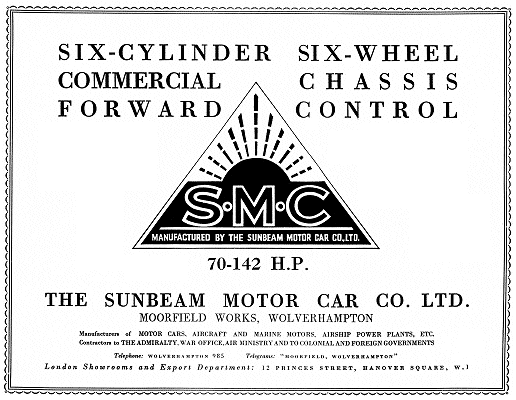 |
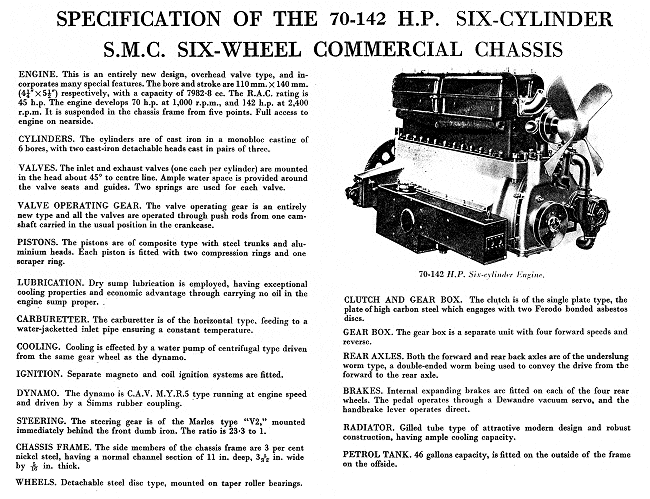

A side view of a completed chassis.
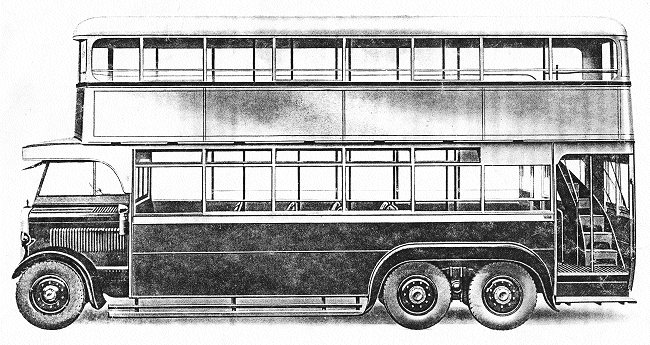
A 6-wheeled chassis fitted with a Dodson body. It
carried 67 passengers.
| In August 1929 a smaller model, the 4-wheeled
‘Pathan’ appeared. It was built to the same high standard as the ‘Sikh’,
and intended for use as a 26-seater, single-deck bus or luxury coach. It
had a 6.597 litre, Sunbeam 6-cylinder engine, capable of delivering 110 b.h.p., and brakes on both front and rear wheels. It seems that very few
‘Sikh’ and ‘Pathan’ chassis were built. |
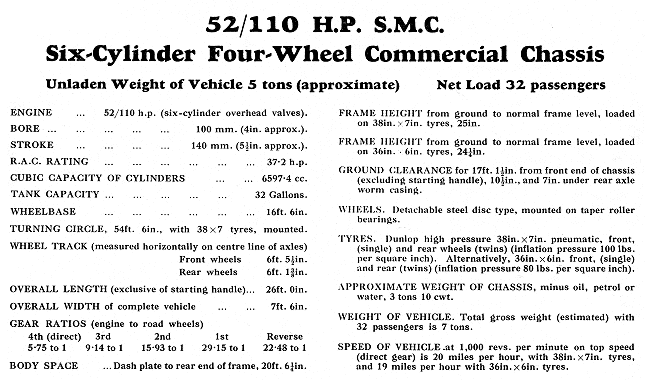
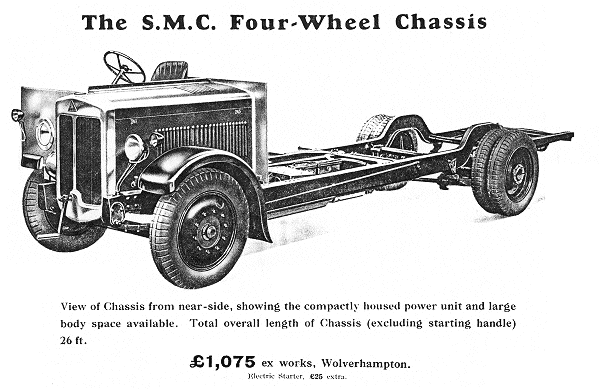
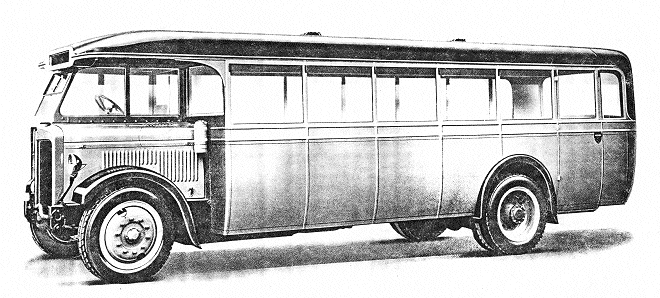
A 4-wheeled 'Pathan' chassis, with a 26 seater de
luxe Short Brothers coach body.
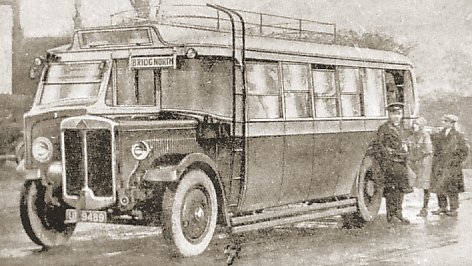 |
A 'Pathan' chassis fitted with a
Sunbeam bus body. It was purchased by Wolverhampton
Corporation and used on the Bridgnorth route.
Courtesy of the late Jim Boulton.
|
|
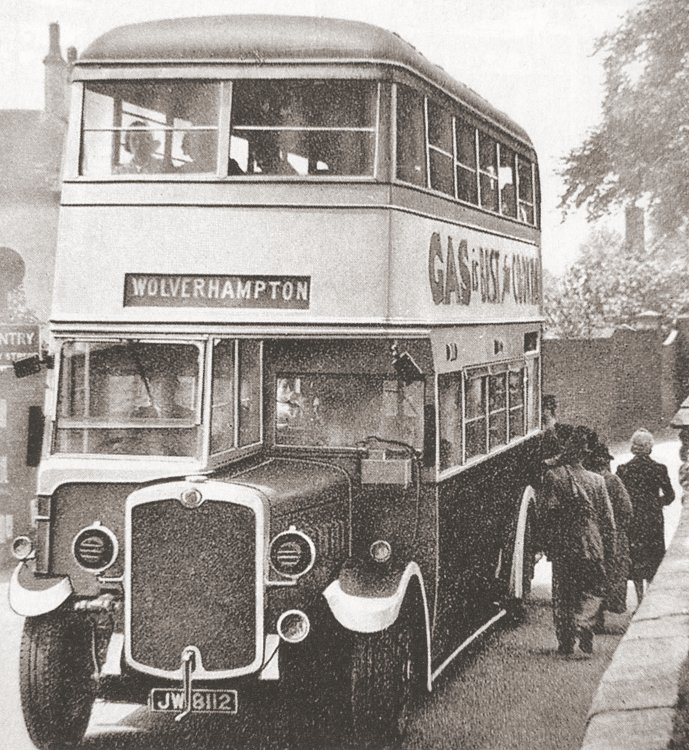
A Sunbeam bus in the early 1940s
in Church Road, Wombourne, outside the church.
|
| Trolley Buses The early 1930s were a difficult time because of
the depression, which lasted for several years. In 1926 Guy Motors
produced the world's first 6-wheeled trolley buses, some of which were used on
Wolverhampton Corporation’s growing trolleybus network. Possibly because
of this, Sunbeam decided to manufacture trolley buses, and in 1931
formed Sunbeam Commercial Vehicles. The standard 6-wheeled chassis was
modified for use as a trolley bus, which became an immediate success.
Large numbers
were produced, and Sunbeam eventually became one of the world's leading
bus chassis manufacturers. |
|
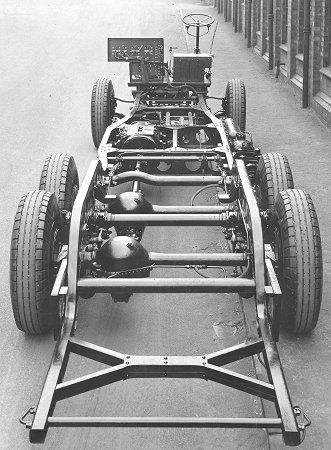
A 6-wheeled trolley bus chassis
outside the factory. |
|
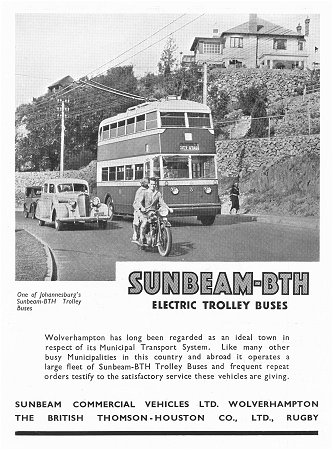
An advert from 1935. |
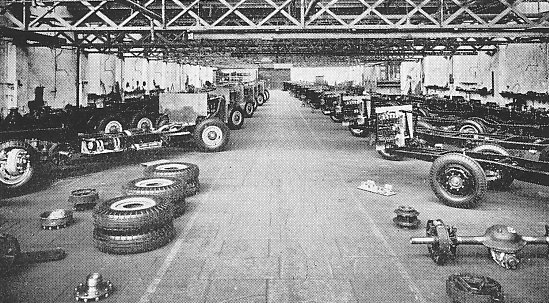
Assembling 4-wheeled chassis at Moorfield Works.
| Another view of chassis production
at Moorfield Works. |
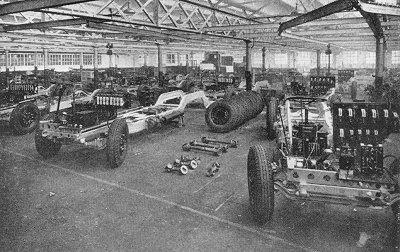 |
| By 1934 the Sunbeam group as a whole was in
financial difficulties, people no longer wanted expensive, slightly
old-fashioned cars. The solution was to be the Sunbeam ‘Dawn’, but it
was slow to sell, and there were initial problems with the design. £3½
million had been spent on development and tooling costs for
the new car, but it wasn’t recovered. At one point, money was so short that wheels and
tyres from half-completed cars had to be removed to meet the weekly wages
bill. On November 17th, 1934 Sunbeam Commercial Vehicles became a
limited company. Things didn’t improve, and Sunbeam soon went into
liquidation. In July 1935 S.T.D. and Sunbeam Commercial Vehicles Limited
was purchased by Rootes Securities, who had no interest in high quality
cars, only volume production. Rootes kept the Sunbeam name and quickly
closed the car building part of the factory. Little interest
was shown in trolley buses, but the bus-building part of Karrier, also owned by
Rootes, was moved from Huddersfield to Moorfields. For a time it looked
as if Sunbeam buses had a secure future.
In December 1935, bus manufacturer AEC (Associated
Equipment Company Limited) became interested in Sunbeam Commercial
Vehicles Limited. AEC’s managing director C. W. Reeve, and AEC’s
chairman J. T. C. Moore-Brabazon joined the board. This resulted in the
production of a Sunbeam bus built on an AEC chassis, and powered by a
Gardner diesel engine. The project seems to have been a
failure because few
were sold. At this time the company also produced battery-powered
vehicles such as milk floats, crankcases for AEC, and stampings for
Ford.
Much of the Moorfields site, where the cars were
built, was soon sold off. By 1944 AEC had lost interest in
Sunbeam Commercial Vehicles Limited. It was sold to the Brockhouse
Group in 1946, after becoming an important source of machine tools for
the group. In 1948 Brockhouse changed the name to the Sunbeam Trolleybus
Company, and in January 1949 it was acquired by Guy Motors. From then-on
all Guy trolleybuses carried the Sunbeam name. |
|
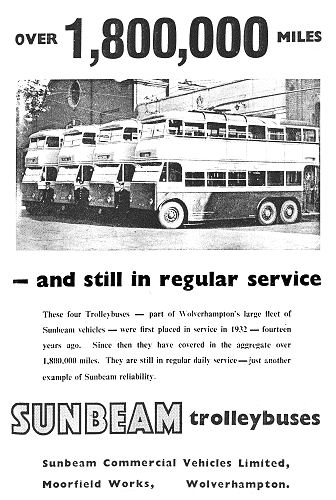
An advert from 1946. |
|
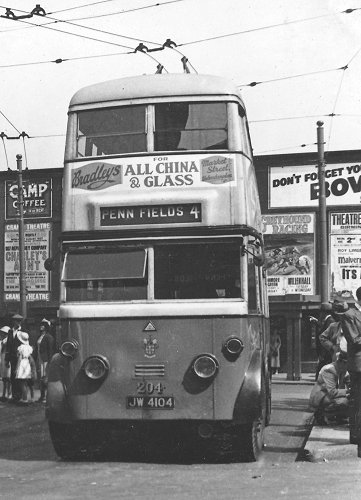
An MS3 chassis with Metro-Cammell
bodywork. |
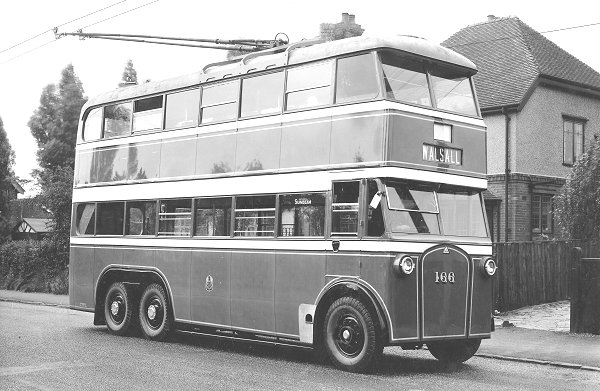
A Sunbeam MS2 chassis with a Weymann body, used by
Walsall Corporation.
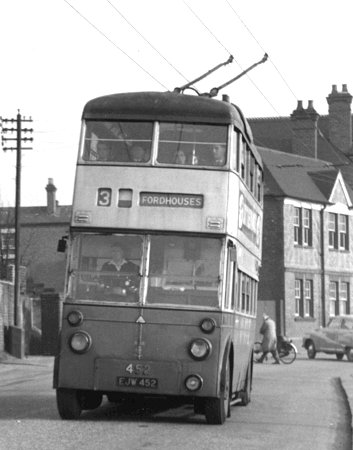
| A Sunbeam W4 chassis
fitted with a Park Royal body. Courtesy of
Eardley Lewis. |
|
Trolleybus production continued at Moorfield Works until 1953
when it was moved to the Guy factory in Park
Lane, were an extension had been built to the machine shop. It was a sad end
for Sunbeam, especially as so much had been achieved during the glorious
half a century at Moorfields. |
| A W4 Sunbeam chassis fitted with a
Park Royal body. It entered service with Wolverhampton
Corporation Transport in 1946 and was withdrawn in 1967.
It is seen here in Stafford Street,
Wolverhampton. Courtesy of Eardley Lewis. |
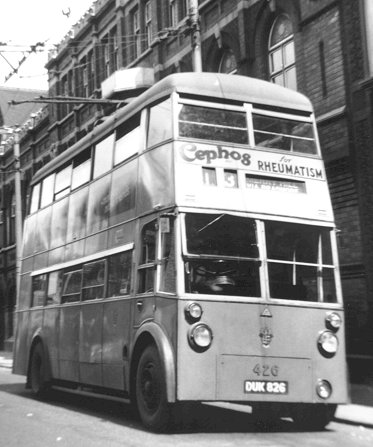 |
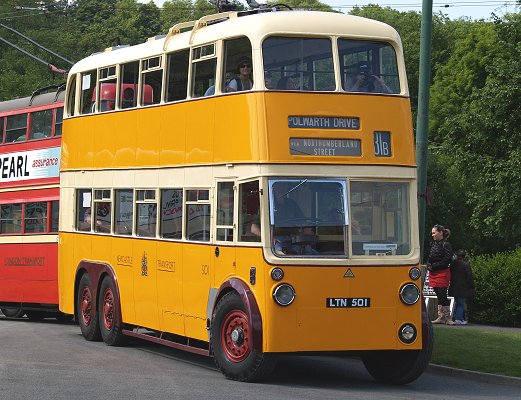
A 6-wheeled Sunbeam trolleybus that
was operated by Newcastle Transport, and is now owned by
Beamish Museum. |
 |
View some pictures of
Sunbeam
trolley buses |
Sunbeam Buses in the
Wolverhampton Corporation Bus Fleet
|
Fleet No. |
Chassis |
Body |
Introduced |
Withdrawn |
| 87 |
Pathan |
Rushton & Wilson |
1930 |
1938 |
| 88 to 90 |
Pathan |
Taylor |
1930 |
1938 |
| 319 |
DF2 |
Brush |
1936 |
1948 |
|
Sunbeam Trolleybuses in the
Wolverhampton Corporation Bus Fleet
|
Fleet No. |
Chassis |
Body |
Introduced |
Withdrawn |
| 92 and 93 |
MS2 |
Weymann |
1933 |
1948 |
| 94 |
MS2 |
Weymann |
1933 |
1947 |
| 95 |
MS2 |
Weymann |
1933 |
1948 |
| 96 |
MS3 |
Metro-Cammell |
1934 |
1948 |
| 97 |
MS3 |
Metro-Cammell |
1934 |
1947 |
| 98 |
MS3 |
Metro-Cammell |
1934 |
1946 |
| 204 |
MS3 |
Metro-Cammell |
1934 |
1945 |
| 205 |
MS3 |
Metro-Cammell |
1934 |
1947 |
| 206 |
MF1 |
Park Royal |
1934 |
1945 |
| 207-209 |
MF1 |
Park Royal |
1934 |
1949 |
| 214-217 |
MS3 |
Beadle |
1934 |
1948 |
| 222 |
MS2 |
Metro-Cammell |
1934 |
1949 |
| 223-226 |
MS2 |
Park Royal |
1935 |
1949 |
| 231 |
MF1 |
Park Royal |
1936 |
1944 |
| 232-233 |
MF1 |
Park Royal |
1936 |
1949 |
| 239-244 |
MF2 |
Park Royal |
1936 |
1949 |
| 245 |
MS1 |
Park Royal |
1936 |
1949 |
| 246-251 |
MF2 |
Beadle |
1937 |
1949 |
| 264-265 |
MF2 |
Park Royal |
1938 |
1949 |
| 266 |
MF2 |
Park Royal |
1938 |
1950 |
| 267-268 |
MF2 |
Park Royal |
1938 |
1949 |
| 269 |
MF2 |
Park Royal |
1938 |
1950 |
| 270 |
MF2 |
Park Royal |
1938 |
1949 |
| 271 |
MF2 |
Park Royal |
1938 |
1950 |
| 272 |
MF2 |
Park Royal |
1938 |
1949 |
| 273 |
MF2 |
Park Royal |
1938 |
1950 |
| 274 |
MF2 |
Park Royal |
1938 |
1949 |
| 275 |
MF2 |
Park Royal |
1938 |
1950 |
| 282 |
MF2 |
Park Royal |
1940 |
1952 |
| 283 |
MF2 |
Park Royal |
1940 |
1950 |
| 284-285 |
MF2 |
Roe |
1940 |
1950 |
| 286-290 |
MF2 |
Park Royal |
1942 |
1952 |
| 291-295 |
MF2 |
Roe |
1942 |
1952 |
| 296-299 |
W4 |
Weymann |
1943 |
1953 |
| 400-401 |
W4 |
Weymann |
1943 |
1953 |
| 402 |
W4 |
Park Royal |
1944 |
1963 |
| 403 |
W4 |
Park Royal |
1944 |
1965 |
| 404 |
W4 |
Park Royal |
1944 |
1963 |
| 405 |
W4 |
Park Royal |
1944 |
1964 |
| 406 |
W4 |
Park Royal |
1944 |
1965 |
| 407 |
W4 |
Park Royal |
1944 |
1964 |
| 408 |
W4 |
Weymann |
1945 |
1965 |
| 409-411 |
W4 |
Park Royal |
1945 |
1965 |
| 412 |
W4 |
Park Royal |
1945 |
1963 |
| 413 |
W4 |
Park Royal |
1945 |
1965 |
| 414 |
W4 |
Park Royal |
1945 |
1963 |
| 415-418 |
W4 |
Park Royal |
1945 |
1965 |
| 419 |
W4 |
Park Royal |
1946 |
1964 |
| 420-423 |
W4 |
Park Royal |
1946 |
1965 |
| 424-427 |
W4 |
Park Royal |
1946 |
1967 |
| 428 |
W4 |
Park Royal |
1946 |
1965 |
| 429 |
W4 |
Park Royal |
1946 |
1967 |
| 430-431 |
W4 |
Park Royal |
1946 |
1966 |
| 432-433 |
W4 |
Park Royal |
1946 |
1967 |
| 434-444 |
W4 |
Park Royal |
1948 |
1967 |
| 445 |
W4 |
Park Royal |
1948 |
1965 |
| 446-449 |
W4 |
Park Royal |
1948 |
1967 |
| 450 |
W4 |
Park Royal |
1948 |
1964 |
| 451-455 |
W4 |
Park Royal |
1948 |
1967 |
| 456 |
F4 |
Park Royal |
1948 |
1963 |
| 457 |
F4 |
Park Royal |
1948 |
1965 |
| 458-459 |
F4 |
Park Royal |
1948 |
1961 |
| 460 |
F4 |
Park Royal |
1948 |
1963 |
| 461 |
F4 |
Park Royal |
1948 |
1965 |
| 462 |
F4 |
Park Royal |
1948 |
1964 |
| 463 |
F4 |
Park Royal |
1948 |
1963 |
| 464 |
F4 |
Park Royal |
1948 |
1964 |
| 465-466 |
F4 |
Park Royal |
1948 |
1965 |
| 467 |
F4 |
Park Royal |
1948 |
1963 |
| 468 |
F4 |
Park Royal |
1948 |
1965 |
| 469-470 |
F4 |
Park Royal |
1948 |
1963 |
| 471 |
F4 |
Park Royal |
1948 |
1964 |
| 472 |
F4 |
Park Royal |
1948 |
1963 |
| 473 |
F4 |
Park Royal |
1948 |
1965 |
| 474-477 |
F4 |
Park Royal |
1948 |
1964 |
| 478 |
F4 |
Park Royal |
1948 |
1965 |
| 479 |
F4 |
Park Royal |
1948 |
1964 |
| 480-481 |
F4 |
Park Royal |
1948 |
1963 |
| 608 |
F4 |
Park Royal |
1949 |
1963 |
| 609 |
F4 |
Park Royal |
1949 |
1962 |
| 610-620 |
F4 |
Park Royal |
1949 |
1963 |
| 621 |
F4 |
Park Royal |
1949 |
1964 |
| 622 |
F4 |
Park Royal |
1949 |
1963 |
| 623 |
F4 |
Park Royal |
1950 |
1962 |
| 624 |
F4 |
Park Royal |
1950 |
1963 |
| 625-626 |
F4 |
Park Royal |
1950 |
1965 |
| 627 |
F4 |
Park Royal |
1950 |
1964 |
| 628-629 |
F4 |
Park Royal |
1950 |
1962 |
| 630 |
F4 |
Park Royal |
1950 |
1964 |
|
Sunbeam Trolleybuses on loan to
Wolverhampton from Bournemouth Corporation
|
Fleet No. |
Chassis |
Body |
Loaned |
Returned |
| 76 |
MS2 |
Park Royal |
1940 |
1948 |
| 84 |
MS2 |
Park Royal |
1940 |
1946 |
| 105 |
MS2 |
Park Royal |
1940 |
1946 |
| 107 |
MS2 |
Park Royal |
1940 |
1946 |
| 129-130 |
MS2 |
Park Royal |
1940 |
1948 |
| 131 |
MS2 |
Park Royal |
1940 |
1946 |
| 132 |
MS2 |
Park Royal |
1940 |
1948 |
| 137 |
MS2 |
Park Royal |
1940 |
1948 |
| 156 |
MS2 |
Park Royal |
1940 |
1946 |
| 161 |
MS2 |
Park Royal |
1940 |
1946 |
| 168 |
MS2 |
Park Royal |
1940 |
1948 |
|
|